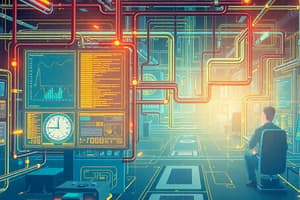Podcast
Questions and Answers
What is the primary function of a hydraulic system?
What is the primary function of a hydraulic system?
- To create electromagnetic fields
- To generate electricity
- To lock and unlock systems
- To control and transmit power (correct)
What type of motion is provided by a linear actuator in a hydraulic system?
What type of motion is provided by a linear actuator in a hydraulic system?
- Non-continuous rotational motion
- Continuous rotational motion
- Rotational motion
- Motion in a straight line (correct)
What is the purpose of a prime mover in a hydraulic system?
What is the purpose of a prime mover in a hydraulic system?
- To drive the pump (correct)
- To generate flow of fluid
- To control the valve
- To create electromagnetic fields
What is the difference between a rotary actuator and a semi rotary actuator in a hydraulic system?
What is the difference between a rotary actuator and a semi rotary actuator in a hydraulic system?
What is an example of an application of a solenoid?
What is an example of an application of a solenoid?
What is the primary function of an actuator?
What is the primary function of an actuator?
What type of actuator uses compressed air as the driving force?
What type of actuator uses compressed air as the driving force?
What is the term used to describe motion in a straight line?
What is the term used to describe motion in a straight line?
What is the main characteristic of a solenoid?
What is the main characteristic of a solenoid?
What is the classification of an actuator based on its movement?
What is the classification of an actuator based on its movement?
What is the output of an actuator?
What is the output of an actuator?
Study Notes
Actuators
- Actuators are devices used to produce action or motion in response to an input signal, which can be electrical, air, or fluids.
- Actuator outputs can be positioned or rate-based, resulting in linear displacement or velocity.
- Actuation can range from a few microns to a few meters.
Types of Actuators
- Hydraulic actuator: uses hydraulic fluid to amplify the control command signal.
- Pneumatic actuator: uses compressed air as the driving force.
- Mechanical actuator:
- Electrical actuators:
- Electric motors
- DC servomotors
- AC motors
- Stepper motors
- Solenoids
Solenoid
- A solenoid is a coil wound into a tightly packed helix that produces a magnetic field when an electric current is passed through it.
- Classified as a type of linear, translational actuator.
- Applications of solenoids include:
- Electromagnets
- Inductors
- Antennas
- Valves
- Medical devices
- Locking systems
- Industrial use
- Automotive systems
Hydraulic Actuator
- Hydraulic systems are used to control and transmit power.
- A pump driven by a prime mover (electric motor) creates a flow of fluid.
- Types of hydraulic actuators:
- Linear actuator (Hydraulic cylinder):
- Provides motion in a straight line.
- Linear displacement depends on stroke length.
- Commonly referred to as cylinders, rams (single-acting cylinders), or jacks.
- Rotary actuators (Hydraulic motors):
- Produces continuous rotational motion.
- Pump shaft is rotated to generate flow.
- A motor shaft is caused to rotate by fluid being forced into the driving chambers.
- Semi-rotary actuators:
- Produces non-continuous rotational motion.
- Limited to less than one revolution.
- Linear actuator (Hydraulic cylinder):
Studying That Suits You
Use AI to generate personalized quizzes and flashcards to suit your learning preferences.
Description
Learn about actuators, devices used to produce action or motion, including their types, functions, and applications in process instrumentation. Understand the input and output signals, and how they can be used to control motion and position.



